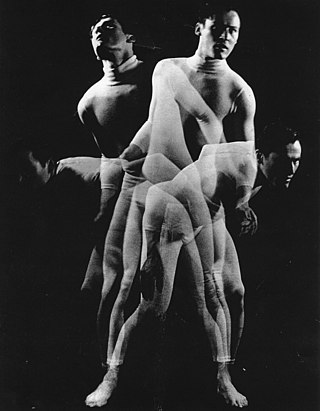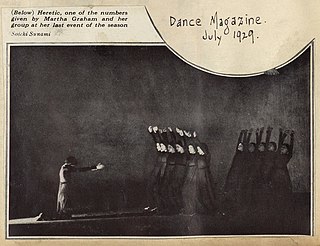Related Research Articles

Agnes George de Mille was an American dancer and choreographer.

Martha Graham was an American modern dancer and choreographer, whose style, the Graham technique, reshaped American dance and is still taught worldwide.

Appalachian Spring is an American ballet created by the choreographer Martha Graham and the composer Aaron Copland, later arranged as an orchestral work. Commissioned by Elizabeth Sprague Coolidge, Copland composed the ballet music for Graham; the original choreography was by Graham, with costumes by Edythe Gilfond and sets by Isamu Noguchi. The ballet was well received at the 1944 premiere, earning Copland the Pulitzer Prize for Music during its 1945 United States tour. The orchestral suite composed in 1945 was played that year by many symphony orchestras; the suite is among Copland's best-known works, and the ballet remains essential in the Martha Graham Dance Company repertoire.

Pearl Lang was an American dancer, choreographer and teacher renowned as an interpreter and propagator of the choreography style of Martha Graham, and also for her own longtime dance company, the Pearl Lang Dance Theater. She is known for Appalachian Spring (1944), American Masters (1985) and Driven (2001).

Episodes is a ballet choreographed by Martha Graham and George Balanchine, to compositions by Anton Webern. The ballet was a co-production between the Martha Graham Dance Company and Balanchine's New York City Ballet (NYCB). Though it was conceived to be a collaboration between Graham and Balanchine, leading choreographers in modern dance and neoclassical ballet respectively, they ultimately worked separately on the ballet's two halves. Episodes I was choreographed by Graham, for dancers from her company and four NYCB members, and depicts Mary, Queen of Scots remembering the events in her life before her execution. Episodes II, by Balanchine, is completely plotless, and made for members of the NYCB and Graham dancer Paul Taylor, who originated a solo. The ballet uses all seven orchestral compositions by Webern.
Cave of the Heart is a one-act ballet choreographed by Martha Graham to music by Samuel Barber. It was first performed on May 10, 1946, with the title Serpent Heart, at the second annual Festival of Contemporary American Music in the McMillin Theater of Columbia University. Serpent Heart was commissioned by the festival sponsor, The Alice M. Ditson Fund.
Errand into the Maze is a Martha Graham ballet based on a poem by Ben Belitt set to music by Gian Carlo Menotti. The surrealistic set was designed by Isamu Noguchi, the costumes by Graham herself. The dance uses the Greek myth of Ariadne and the Minotaur to explore the theme of conquering one's inner demons, more specifically the fear of sexual intimacy. The piece premiered at the Ziegfeld Theatre on February 28, 1947, with Graham as the protagonist, a sort of female Theseus, and Mark Ryder as the Minotaur-like character.

Every Soul Is a Circus is a comedic ballet choreographed by Martha Graham. The dance premiered on December 27, 1939, at the St. James Theatre in New York City. The original score was composed by Paul Nordoff. Philip Stapp created the set. Edythe Gilfond designed the costumes. The production marked the first appearance of Merce Cunningham with the Martha Graham Dance Company.
Deaths and Entrances is a ballet choreographed by Martha Graham performed to music by Hunter Johnson. Arch Lauterer created the original set; Edythe Gilfond designed the costumes. The ballet was well-received from the first performance despite being labeled as one of Graham's most personal, least accessible works. Oscar de la Renta created new costumes for the ballet's 2005 revival. The piece premiered on July 18, 1943, at Bennington College in Bennington, Vermont. The first performance was an informal preview for which the dancers wore practice clothes although the set was in place.

Bertram Ross was an American dancer best known for his work with the Martha Graham Dance Company, with which he performed for two decades. He was Martha Graham’s longtime dance partner and the originator of male roles in most of her major ballets from the 1950s and 1960s, including Adam in Embattled Garden, and both Agamemnon and Orestes in Clytemnestra. After leaving Graham's company, Ross taught, choreographed and formed his own dance company. In later life, he toured in a cabaret duo with his real life partner, the composer and pianist John Wallowitch.
American Document is a modern dance work choreographed by Martha Graham in response to rising Fascism in 1930s Europe. The piece premiered on August 6, 1938 at the Vermont State Armory in Bennington, Vermont. The ballet features spoken word excerpts from the Declaration of Independence and Emancipation Proclamation, among other texts. The set was created by Arch Lauterer; the costumes were designed by Edythe Gilfond. The original music was written by Ray Green. Graham extensively reworked the choreography in 1989. John Corigliano's Oboe Concerto replaced Green's music for the revised version.

Stuart Hodes was an American dancer, choreographer, dance teacher, dance administrator and author. He was Martha Graham's partner, danced on Broadway, in TV, film, in recitals, and with his own troupe. His choreography has appeared on the Boston Ballet, Dallas Ballet, Harkness Ballet, Joffrey Ballet, San Francisco Ballet and other troupes. He taught at the Martha Graham School, Neighborhood Playhouse, NYC High School of Performing Arts, headed dance at NYU School of the Arts and Borough of Manhattan Community College. He was Dance Associate for the NY State Council on the Arts, dance panelist for the National Endowment for the Arts, president of the National Association of Schools of Dance, and a member of the First American Dance Study Team to China in 1980, returning in 1992 to teach the Guangzhou modern dance troupe.
Salem Shore is a solo modern dance work choreographed by Martha Graham to original music by Paul Nordoff. The piece premiered on December 26, 1943 at the 46th Street Theater in New York City. The ballet featured costumes by Edythe Gilfond and a set by Arch Lauterer. Program notes accompanying the first performance described the dance as "a ballad of a woman's longing for her beloved's return from the sea."

Heretic is a modern dance work by Martha Graham performed to Tetus Breton, an old folk tune from Brittany. Louis Horst, Graham's musical director, recommended the song, part of the collection Chansons de la Fleur de Lys as arranged by Charles De Sivry. The dance premiered with the title Heretic at New York's Booth Theatre on April 14, 1929. In a previous program announcement, the work was called A Faith. Graham presented the piece with her company; the performance marked the debut of her concert ensemble. Heretic is staged for 13 female performers, 12 dressed in black tube-like garments and one in a long white dress. Dancers for the premiere were: Graham, as the woman in white, Kitty Reese, Louise Creston, Irene Emery, Ethel Rudy, Lillian Ray, Hortense Bunsick, Sylvia Wasserstrom, Mary Rivoire, Ruth White, Lillian Shapero, Virginia Briton, Sylvia Rosenstein, Evelyn Sabin, Betty Macdonald and Rosina Savelli.
Judith is a solo work created by dancer/choreographer Martha Graham. William Schuman composed the music. Charles Hyman designed the original set, which was replaced almost immediately by one conceived by Isamu Noguchi. He also added jewelry and a headdress. Jean Rosenthal provided the lighting. The piece premiered on January 4, 1950, at the Columbia Auditorium in Louisville, Kentucky.
Frontier is a solo dance choreographed by Martha Graham to music by Louis Horst. The set was designed by Isamu Noguchi; Graham created the costume. The work began as an ensemble piece, Perspectives: Frontier and Marching Song also known as Frontiers and Frontier. The ballet's Marching Song portion was set to music by Lehman Engle. The work premiered on April 28, 1935, at the Guild Theatre in New York City. By the end of 1935, Graham was performing Frontier exclusively as a solo. The piece was the first of her works to explore American identity through an archetypal character.
Night Journey is a Martha Graham ballet performed to music by William Schuman with costumes designed by Graham and a set by Isamu Noguchi. Commissioned by the Elizabeth Sprague Coolidge Foundation of the Library of Congress, the work premiered on May 3, 1947, at Cambridge High School in Boston, Massachusetts. Night Journey is the third of Graham's dances derived from Greek mythology, following Cave of the Heart and Errand into the Maze.
Chronicle is a modern dance work choreographed by Martha Graham to music by Wallingford Riegger. It premiered on December 20, 1936, at the Guild Theatre in New York City. The set was designed by Isamu Noguchi. Riegger's music was scored for piano, wind instruments and percussion; Noguchi's set was made up primarily of curtains, platforms and stairs. The original production was danced by Martha Graham and Group, the forerunner of the Martha Graham Dance Company. According to the program notes, the dance is based upon "the advent and consequences of war" and concerned itself with the "contemporary situation", referring to the impending conflict in Europe.
Course was a modern dance work choreographed by Martha Graham to music by George Antheil. The piece sometimes appeared on programs as Course: One in Red; Three in Green; Two in Blue; Two in Red. It premiered on February 10, 1935, at the Guild Theatre in New York City. The ballet was performed by Martha Graham and Group, the forerunner to the Martha Graham Dance Company.

Blakeley White-McGuire born in Baton Rouge, Louisiana, is a dancer, choreographer, répétiteur, and educator. She is a Principal Guest Artist and former Principal Dancer of Martha Graham Dance Company. Described by Gia Kourlas of the New York Times as having a "powerful technique and dramatic instinct with an appealing modern spunk", White-McGuire has received widespread critical acclaim as a Graham dancer.
References
- ↑ Diversion of Angels (Ballet choreographed by Martha Graham), Performing Arts Encyclopedia, The Library of Congress
- ↑ Catton, Pia. "A Deluge of New Dance Ideas". The Wall Street Journal. Retrieved 17 March 2016.
- ↑ Herridge, Frances (17 August 1948). "Graham Work Needs Graham". memory.loc.gov. Retrieved 17 March 2016.
- 1 2 3 "DIVERSION OF ANGELS". www.abt.org. Retrieved 17 March 2016.
- ↑ "Martha Graham & Modern Dance". Angelfire . Retrieved 17 March 2016.
- ↑ Stuart Hodes, Part Real, Part Dream: Dancing with Martha Graham, Concord ePress, 3rd edition, August 2011, location 1495
- ↑ Kisselgoff, Anna (26 October 1999). "DANCE REVIEW; A Classical Approach To the Graham Karma". The New York Times. Retrieved 17 March 2016.